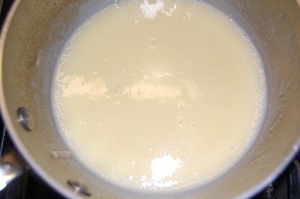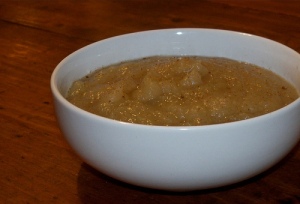
You don’t have to limit yourself to zucchini lasagna. Photo credit sexyliciousness via photopin.
by Karen Frazier
When I tell people I have celiac disease and can’t eat gluten, and that I further choose to eat low-carb paleo to help health conditions and keep my weight in check, one of the most common reactions I get is this one: “I could NEVER give up pasta!”
I get it – I truly do. Back in the day, I loved pasta. It was cheap, versatile, delicious, and easy way to get totally creative in the kitchen. Sadly, I love pasta, but it doesn’t love me even a little bit.
Since I eat mostly low-carb paleo, pasta is a thing of the past for me. I can’t eat gluten-free pasta substitutes (often made from corn flour, rice flour, or a combination of various legume-based flours). But I still enjoy a tasty pasta-style dish from time to time, such as my low-carb paleo lemon and artichoke shrimp scampi on zoodles.
With years of low-carb and paleo experience under my belt in a household of picky eaters, here are some of my best low-carb and/or paleo pasta hacks.
 1. Spiralize “Zoodles” and Other Veggie Noodles.
1. Spiralize “Zoodles” and Other Veggie Noodles.
If you’re not new to the paleo world, chances are you’ve made a batch of zoodles – or another kind of veggie noodles – in your day. In fact, I’ve written an entire cookbook about making noodles out of veggies using a handy little gadget called a spiralizer. I use the Paderno World Spiralizer, and all you’ve got to do is crank the handle to get super cool “noodles” that make a great stand-in for pasta if you’ve either chosen or been forced into a gluten-free lifestyle. Try it, you’ll like it.
2. Make Veggie Peeler Noodles.

Dual veggie and julienne peeler from Precision Kitchenware
Limited shelf-space or no room in the budget for yet another gadget – or both? No worries. If you’ve got a veggie peeler and a knife, then dang it, you’ve got oodles of zoodles and other veggie noodles. It’s pretty easy. Use a veggie peeler to cut the vegtables into ribbons. Then, either leave wide ribbon style veggie pasta, or use a paring knife to cut the noodles into smaller shapes.
You can also try a julienne peeler, which will cut the veggies into angel-hair like strips. No need to clutter your drawers with both, however. Many manufacturers make peelers that do double duty, working as both a veggie and julienne peeler. Clever!
3. Choose Veggies That Noodle.
That’s right. Noodle is a verb. Of course, not all veggies are created equal when it comes to noodling around. Some veggies make much better noodles than others. Try noodling:
- Zucchini and other summer squash (peeled or unpeeled)
- Sweet potato
- Winter squash
- Carrots
- Parsnips
- Beets
- Other solid root veggies
To cook the veggie noodles, I recommend sautéing them in your fat of choice, sprinkled with a little salt, for two to five minutes, until they are al dente.
 4. Use The Aptly Named Spaghetti Squash.
4. Use The Aptly Named Spaghetti Squash.
So what if you abhor kitchen gadgets of all kinds (I can’t imagine anyone not loving a kitchen gadget, but that’s just me, owner of a Ginsu knife that supposedly can hack through an aluminum can in one clean slice), so making fancy noodles is out? If you have an oven, a baking sheet, a fork, and a sharp knife, you can still make veggie noodles from spaghetti squash.
- Preheat your oven to 400 degrees Fahrenheit.
- Cut the squash in half lengthwise.
- Place it cut-side down on a baking sheet and bake it in the preheated oven until it is tender, 30 to 45 minutes.
- Remove it from the oven. Use a fork to pull the flesh away from the rind in “noodles” and go forth with whatever sauce sounds tasty to you.
5. But What About Lasagna and Stuffed Pasta Dishes?
 I’m so glad you asked. Of course, you can use thinly sliced eggplant or zucchini as your lasagna noodles or as a pasta to wrap around filling. Here are some tips:
I’m so glad you asked. Of course, you can use thinly sliced eggplant or zucchini as your lasagna noodles or as a pasta to wrap around filling. Here are some tips:
- Use a mandoline for paper-thin slices.
- I recommend if you do this, you place the thin slices of veggies in a colander in the sink and salt them. Then, after about 30 minutes, wipe away the salt completely and use the veggies. The salt will draw off excess water so you won’t wind up with a watery dish. Go forth and make your lasagna or stuffed pasta.
6. But What if I Can’t Stomach Another Noodle Made From Veggies?
Here’s the thing. It’s okay to be super sick of veggie noodles and you want something a little different. In this case, I offer a tried and true idea from the Frazier household to yours that will change the way you make low-carb lasagna. Use thin slices of salami as your noodles. I’ll allow a moment for the genius of this idea to sink in before I continue. Salame. Thinly sliced (or another deli-sliced meat you like). Use it as your noodle layers or wrap it around a filling. Of course, you could also use large pieces of kale or spinach, but doesn’t using pre-sliced salami, crisp cooked slices of bacon or pancetta, or some lovely Canadian bacon sound somehow much tastier?
This is one of my favorite low-carb maxims – when in doubt, wrap it in meat, baby! You’re welcome!
7. Whip Up a Truly Great Tomato Sauce.
A good tomato sauce is shockingly easy. It takes a bit of time, of course, but most of that is time you can spend reading a book as the sauce simmers to allow the flavors to blend. Here’s my super easy and tasty tomato sauce.
- 2 tablespoons fat of your choice
- 1 onion, finely chopped
- 6 garlic cloves, minced
- 1 teaspoon dried oregano (or Italian seasoning blend)
- 2 (15-ounce) cans crushed organic tomatoes (I love Muir Glen, which has no sugar added), drained
- 1/2 teaspoon sea salt
- Pinch red pepper flakes
- 1/4 cup chopped, fresh basil
- In a large saucepan, heat the fat on medium-high until it shimmers.
- Add the onion and cook, stirring occasionally, until the onions begin to brown, about five minutes.
- Add the garlic and oregano and cook, stirring constantly, until it is fragrant, about 30 seconds.
- Add the tomatoes, salt, and red pepper flakes. Simmer on low, stirring occasionally, until the sauce is the desired consistency and the flavors are blended, 30 to 45 minutes.
- Stir in the basil.
8. Make a Tasty Low-Carb White (Béchamel) Sauce.
Béchamel, Alfredo, and other white pasta sauces usually start with a roux of butter and flour, so they tend to a) have gluten; and b) be a bit carby. This low-carb, gluten-free version isn’t paleo unless you include grass-fed, organic dairy as part of your paleo repertoire, but it’s really, really tasty either as a sauce by itself on one of your pasta substitutes, or combined with other meats and veggies, like chicken and broccoli or ham, spinach, and mushroom.
- 1/4 cup grass-fed unsalted butter
- 8 ounces grass-fed cream cheese
- 1/4 cup grass-fed heavy cream
- 1 cup grated grass-fed parmesan or asiago cheese
- In a medium pot, combine all the ingredients.
- Cook on medium-low, stirring constantly, until all the components are melted, and the sauce is well combined and smooth.
Pasta on, my Friends!
These are a few of my favorite ways to keep pasta-like dishes in my life. Combine your creativity with these tricks, and you won’t miss pasta a bit.

 by
by 


 4. Use The Aptly Named Spaghetti Squash.
4. Use The Aptly Named Spaghetti Squash.




